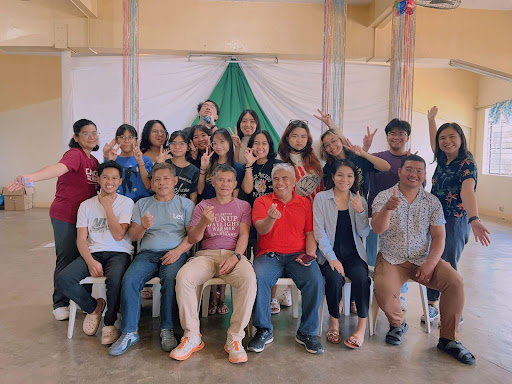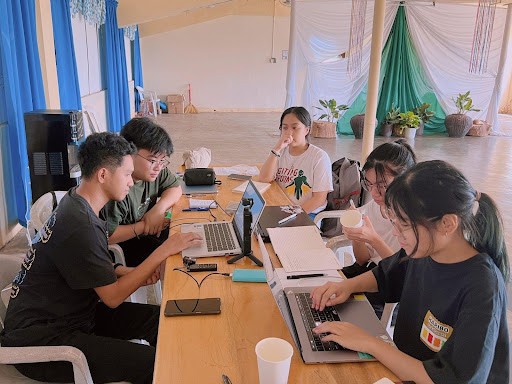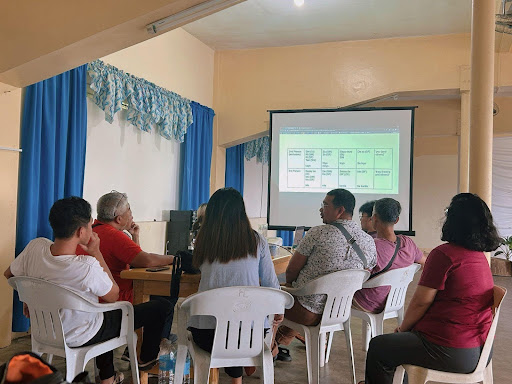
Danica Ann Barbuco, Ian Bartolome, Harriet Gabrielle Malapit, Patricia Anne Ocampo, Maria Clarissa Quiambao | Lingg 125 X3-1
Posted on August 29, 2025

Linguistics, as a field of study, is adept at subverting people’s expectations.
At first glance, it seems to be a discipline where one aims to become proficient in as many languages as possible, particularly foreign ones. Hence, even students of linguistics tend to be caught off guard by its intricacies and its focus on indigenous languages of the Philippines, which raises questions as to what exactly makes this field significant?
It was the course Linguistics 125 (Lingg 125), titled Introduction to Field Methods, that gave us the answer to these questions, but not before deviating from our initial expectations of it as well.
Lingg 125 for the Midyear Term, AY 2024-2025 was divided into three (3) sections: two sections were to conduct fieldwork within Metro Manila, while one was to do so outside Metro Manila. Our class comprised the latter section, and we were to stay in Nueva Vizcaya for two (2) weeks, from 30 June to 11 July.
Nueva Vizcaya as our field site wasn’t a random choice. Our time on the field was a direct offshoot of previous projects in our Department, as the working relationship with the Bugkalot/Eģongot community started during the 1960s. In fact, ours was the second phase of the extension project, “Developing a community-led documentation project for Bugkalot.” We have a lot riding on us, and so everyone knew about and felt the pressure that came with it.
Each of our interview sessions with the community members served a different purpose. While some of us gathered data about the uses and conditions of the language, the others would work on dictionary building, or even the digitizing of legacy materials. But the experience was far from what we expected: we learned a lot about linguistic methods, but we also deeply enjoyed our time with the community members even after our sessions ended.

At first, we thought that being on the field was a constant struggle, seeing as that was what the first few days brought us. It was an experience that none of us have been privy to in the past, so we knew we had to learn to strategize to figure out how we were to navigate the next two weeks of being in Nueva Vizcaya together.
There were many adjustments that had to be made during this fieldwork because of expectations that had not been met. Time was one of the first expectations that this class subverted. Initially, we thought that fieldwork would only span class hours. However, work did not end the moment the video and audio recorders were turned off. After an entire day of work, we had to back-up files, clear the SD cards, and update the metadata sheet with the necessary information about the recordings. It felt as though we were constantly moving, and that there was no time for rest. Our days were filled with endless interaction and tech work. Naturally, this gave us the impression that our fieldwork was never going to be as easy as we expected it to be. You would think it was going to be easier to work as a group, seeing as we were 10 people collaborating with each other. Unfortunately, our first day immediately shattered that fantasy.
Besides the fieldwork schedule, we also had to adjust to our environment, as well as living with each other for those two weeks. During the first few days of living together in Nueva Vizcaya, it took some time for us to adjust to each other’s habits as temporary roommates. This part was not as much of a struggle compared to the fieldwork part since we were already friends—hence the familiarity—but there were still a few gaps to be filled. The environment, however, was a different story. Living away from home—or what people consider a home for a semester—for two weeks was met with feelings of excitement, anticipation, and a little bit of stress as we learned to work around each other’s little quirks, habits, and daily routines, especially for those who have never experienced living far from home in a campus hostel. It took most of us a few days to get well-adjusted to the environment as well. Despite Bayombong, Nueva Vizcaya being urbanized, it was still not the city we had gotten used to; it was, more or less, nine hours away from where UP stands. Other than that, it was also on a higher altitude, and every time we walked, it felt more challenging because of the incline.
In spite of our first impression of the field being challenging because of the fact that we had gotten used to living in the city during the school years, the experience forever remains a memory etched in our minds, brought up in little anecdotes every now and again.

Our 10-day fieldwork in Nueva Vizcaya taught us a lot about ourselves, the community, and the nature of our work in linguistics. For one, language documentation is indeed challenging and intimidating. It covers many tasks, with varying degrees of difficulty and responsibility. For us, it came in the form of validating archival materials and gathering contemporary data for further analysis and language description—and even then, we were barely scratching the surface. It’s an entire process that spans years (even decades) of working together with the community so that a comprehensive record of Bugkalot/Eg̓ongot may be preserved. But, despite the long hours and heavy workloads, seeing the community’s dedication to their language and desire to participate and collaborate with us makes it all the more worthwhile and fulfilling.
Among the community members, many have expressed enthusiasm and a deep appreciation for the work we’ve been doing so far on Bugkalot/Eg̓ongot. One in particular said that he will never get tired of being a language consultant because he loves his language and culture. Another also consistently tells us that he’s thankful for initiatives like these because it helps even the community better understand and appreciate their language. He said that while we, linguists, were there to study their language, they were learning alongside us, too. The Bugkalot/Eģongot community is one that appreciates and cares for its language passionately. They often express this verbally, but it is also evident in their efforts to show up to our daily sessions even if it would mean 4 to 6 hours of travel for some of them. They would keep talking about their language, sharing bits and pieces of information, and telling us about their dreams for Bugkalot/Eģongot.
At the end of our time in Nueva Vizcaya, it was evident that all of our lives were changed one way or another. All of us grew a newfound recognition of the realities of Philippine languages and language documentation, and made lifelong friends along the way. So, if there’s one thing to say about our experience on the field, it’s to give yourself and others a chance—to grow, to learn, and to bounce back. The field is unpredictable which makes the experience even more unforgettable. You never really know what you’re going to get out of it if you don’t go out and try.
As we stepped in the field, we were filled with worries and doubt. What if we weren’t ‘good enough’? What if we still lacked the capabilities to be in the field? We all had the same thoughts from the beginning. We knew we were going to be nine hours away from home—in a place we never stepped foot in before, and a language unfamiliar to us. On top of that, “language documentation” seems like a daunting job, all because it is. But being in the field, we grew out of these fears. We learned to go beyond our own comfort zones and see what else lies in the usual everydays of our linguistics classes. Each day was a learning opportunity. While we discovered a lot about the Bugkalot/Eģongot community and their language, we also learned so much about ourselves and what we can do, both individually and collectively.
